Early 18th Century George I Figured Walnut Bureau Bookcase
England Circa 1720
Price on Application
Follow Us
Early 18th Century George I Figured Walnut Bureau Bookcase, England Circa 1720
A superb and exceptionally well proportioned early 18th century figured walnut ‘pagoda topped’ double dome bureau bookcase, circa 1720 England.
The upper section is surmounted with what is believed to be the original solid walnut finials and soft bevelled mirror plates, opening to a removal bank of walnut veneered and feather banded drawers, cantered by pigeonholes below two shelves. Candle slides are neatly stowed below the bookcase doors to reflect the light.
To the moulded bureau, the fall opens to reveal pigeonholes, long and short asymmetric drawers each beautifully veneered in figured walnut and feather banded, cantered by a cupboard door which neatly conceals an open compartment and drawer. Below the fall, two short and two long graduating oak lined drawers are each book-matched in superb sections of hand-cut figured walnut veneers over bun feet.
It should be noted that this exceptional desk and bookcase, is not only of the finest cuts of figured walnut veneer but exquisitely made at the pinnacle of design which had gradually evolved predominantly in London, during the late 17th and early 18th century.
The actual description ‘desk-and-bookcase’ appears to be first recorded in the accounts of the Royal cabinet-maker Gerrit Jensen (fl.1680-d.1715) who supplied several for the Royal Household from 1710 (Bowett, op. cit.), and another described as ‘a walnut writing desk, the top for books and patons and glass in the doors asked’ for the 5th Earl of Salisbury, Hatfield House. Another maker of this form of desk was the London cabinet-maker John Gumley (1691-1727) who advertised in Richard Steele’s Lover on April 24 1714 that he ‘hath taken for a Ware-house, and furnished all the upper part of the New Exchange in the Strand’ continuing with an extensive list of his stock including ‘Desks and Bookcases.’ In 1714 he supplied one of these in walnut to James 1st Duke of Montrose for the sum of £11.
Russian cabinetwork of this period was strongly influenced by Tsar Peter I return to Russia after his studies in London. He subsequently sent twenty-four cabinetmakers who were working in Amsterdam to London to train as furniture makers. One of these cabinetmakers named Fedor Martynov made furniture for the Empress Anna Ioannovna. Martynov’s drawings are almost identical to the present piece.
Dimensions
Height: 90.56 in. (230 cm)
Width: 40.56 in. (103 cm)
Depth: 23.23 in. (59 cm)
Literature
Mallett’s Great English Furniture, London: Bullfinch Press 1991, p.248, fig 287, by Lanto Synge,
English Furniture 1660 – 1714 From Charles II to Queen Anne, by Dr Adam Bowett,
Woodbridge: Antique Collector’s Club, 2002 Chapter 7 Case Furniture 1689 – 1714 pp.221-223 fig. 7:53
A walnut bureau bookcase of the same form and period sold from the private collection of Patricia Kluge at Albemarle House in Virginia, USA on the 9th June 2010
PREVIOUSLY SOLD
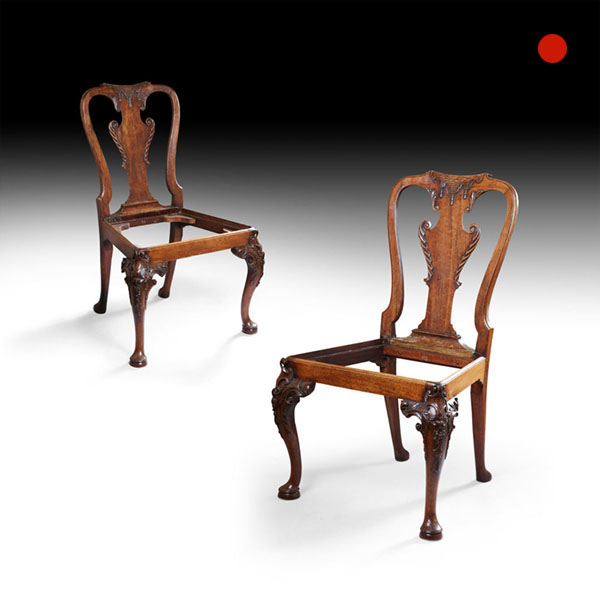
George I Carved Irish Walnut Pair of Chairs
A rare and fine pair of Irish George I walnut side chairs of excellent colour and patina, circa 1720. The undercut shaped back-splats of violin form are beautifully and naturally carved in acanthus leaves, returning into eared scrolls, topped by a crest rail depicting curtain swags and fine hanging passementerie.
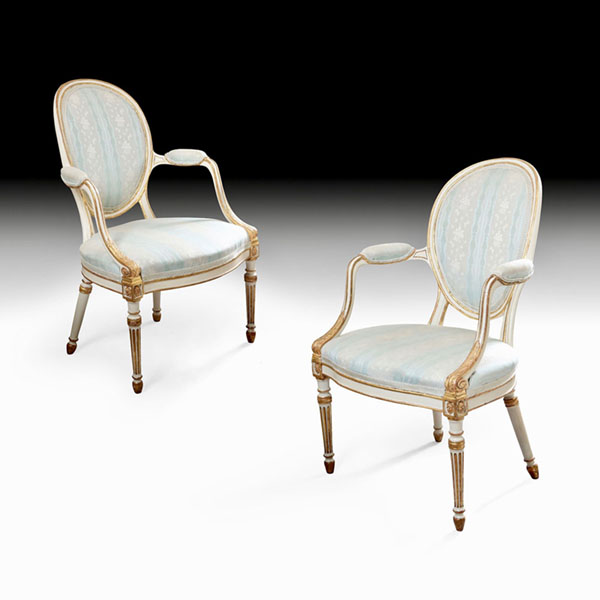
George III Parcel Gilt Painted Pair of Chairs
A fine pair of painted and carved George III English chairs in the French taste, upholstered in silk damask.
Possibly by John Linnell.
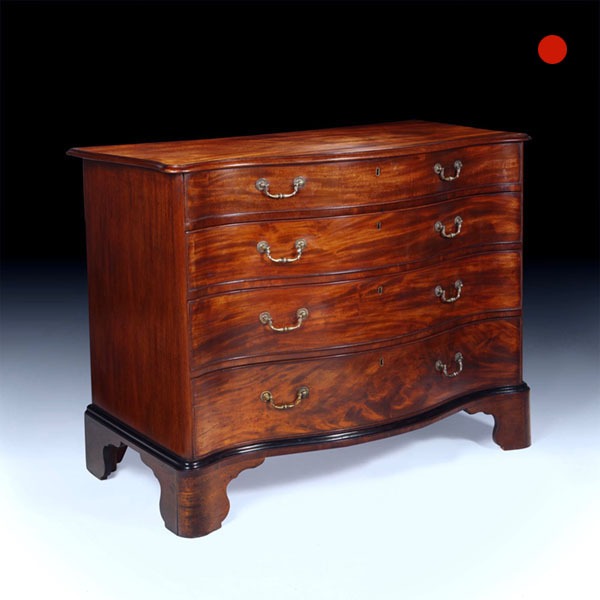
George III Mahogany Serpentine Chest of Drawers
Dating from one of the most famous and highly celebrated periods in English furniture history, now known as the ‘Chippendale period’.
This fine George III mahogany serpentine chest is very much in the manner of Thomas Chippendale.
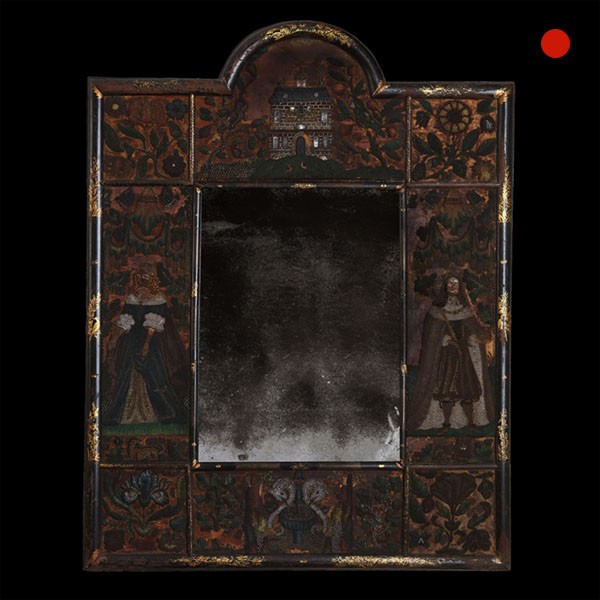
17th-Century Beadwork/Stumpwork Japanned Mirror
Advances in English domestic glass production in the second half of the century coincided with the fashion for stumpwork and resulted in the production of some of the most spectacular examples being produced.
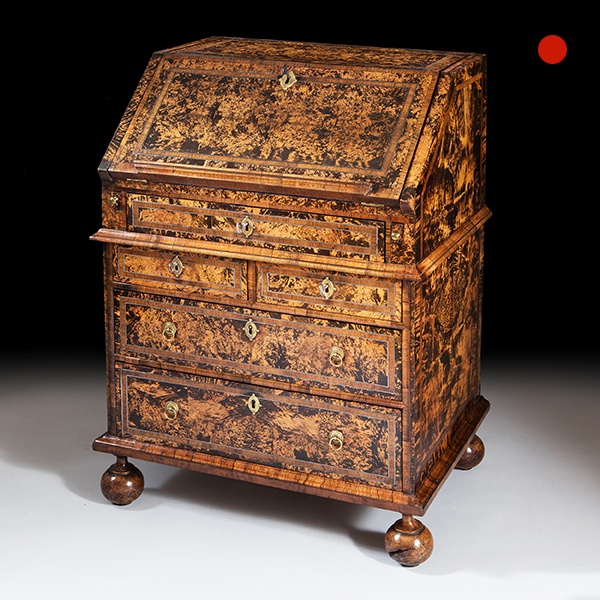
Queen Anne Mulberry Bureau Firmly Attributed to Coxed and Woster, circa 1710 England
Queen Anne Mulberry Bureau Firmly Attributed to Coxed and Woster circa 1710 England SOLD Follow UsQueen Anne Mulberry Bureau Firmly Attributed to Coxed and Woster, circa 1710 England This magnificent Queen Anne 'Mulberry Wood' (field maple) bureau of small proportion...
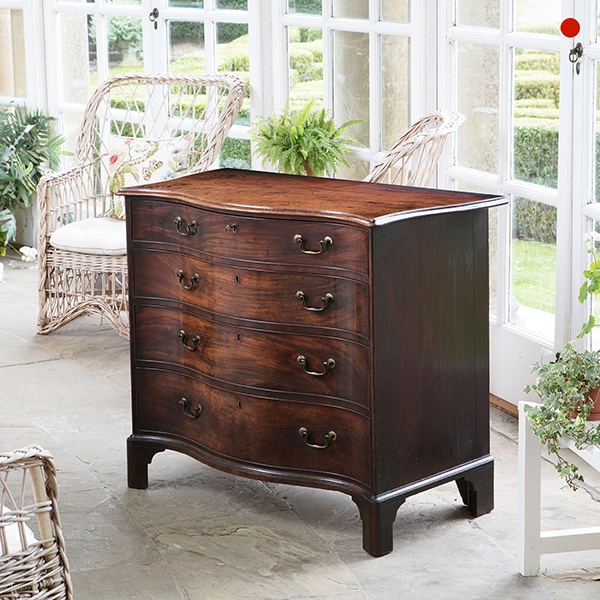
A fine George III mahogany serpentine chest of drawers in the manor of Henry Hill of Marlborough
A fine George III mahogany serpentine chest of drawers in the manner of Henry Hill. With ebonised, ogee moulded serpentine dovetail-housed top.

George I Carved Irish Walnut Pair of Chairs
A rare and fine pair of Irish George I walnut side chairs of excellent colour and patina, circa 1720. The undercut shaped back-splats of violin form are beautifully and naturally carved in acanthus leaves, returning into eared scrolls, topped by a crest rail depicting curtain swags and fine hanging passementerie.

George III Parcel Gilt Painted Pair of Chairs
A fine pair of painted and carved George III English chairs in the French taste, upholstered in silk damask.
Possibly by John Linnell.

George III Mahogany Serpentine Chest of Drawers
Dating from one of the most famous and highly celebrated periods in English furniture history, now known as the ‘Chippendale period’.
This fine George III mahogany serpentine chest is very much in the manner of Thomas Chippendale.

17th-Century Beadwork/Stumpwork Japanned Mirror
Advances in English domestic glass production in the second half of the century coincided with the fashion for stumpwork and resulted in the production of some of the most spectacular examples being produced.

Queen Anne Mulberry Bureau Firmly Attributed to Coxed and Woster, circa 1710 England
Queen Anne Mulberry Bureau Firmly Attributed to Coxed and Woster circa 1710 England SOLD Follow UsQueen Anne Mulberry Bureau Firmly Attributed to Coxed and Woster, circa 1710 England This magnificent Queen Anne 'Mulberry Wood' (field maple) bureau of small proportion...

A fine George III mahogany serpentine chest of drawers in the manor of Henry Hill of Marlborough
A fine George III mahogany serpentine chest of drawers in the manner of Henry Hill. With ebonised, ogee moulded serpentine dovetail-housed top.
YOU MAY ALSO LIKE
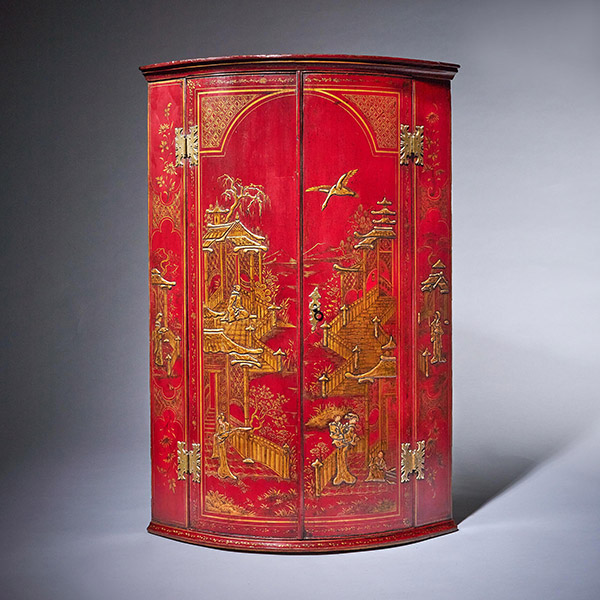
18th Century George II Scarlet-Red Japanned Corner Cupboard Att. Giles Grendey
18th Century George II Scarlet/Red Japanned Corner Cupboard, Att. Giles Grendey Follow Us18th Century George II Scarlet/Red Japanned Corner Cupboard, Att. Giles Grendey A fine and rare early 18th century George II scarlet japanned chinoiserie...
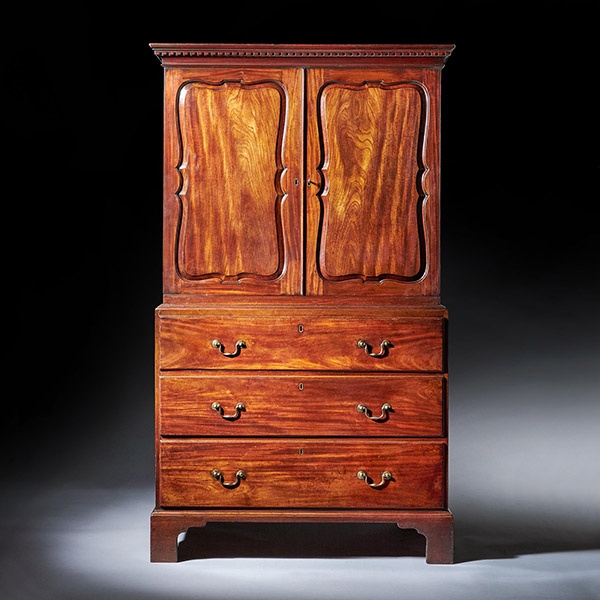
18th-Century George II Mahogany Secretaire Linen Press, Attributed, Giles Grendey
18th-Century George II Mahogany Secretaire Linen Press, Attributed, Giles Grendey £10,800[wpforms_selector form_id="11387" show_title="on" _builder_version="4.22.1" _module_preset="default" custom_margin="-30px||||false|false"...

Signed Mid 19th C. Edo/Meiji Period Diminutive Lacquer Stacking Cabinet, Japan
Signed Mid 19th C. Edo/Meiji Period Diminutive Lacquer Stacking Cabinet, Japan £5,800Follow UsSigned Mid 19th C. Edo/Meiji Period Diminutive Lacquer Stacking Cabinet, Japan The highly decorated tray in the form of a table frames a series of...

Late Edo Period 19th Century Japanese Pillar Clock, Shaku-Dokei, C. 1820
Late Edo Period 19th Century Japanese Pillar Clock, Shaku-Dokei, C. 1820 £6,500Follow UsLate Edo Period 19th Century Japanese Pillar Clock, Shaku-Dokei, C. 1820 ELEGANT JAPANESE PILLAR CLOCK, 'SHAKU-DOKEI', c. 1820 The very fine 30-hour,...
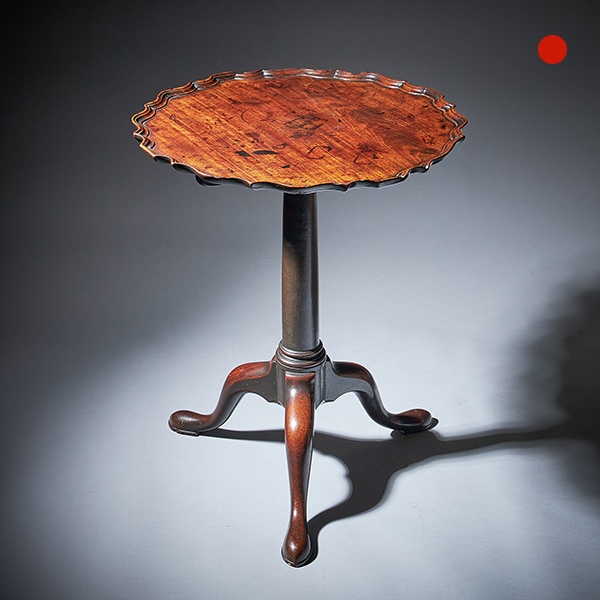
George II Gun Barrel Mahogany Tripod Table, circa 1740-1750
George II Gun Barrel Mahogany Tripod Table, circa 1740-1750 SoldFollow UsGeorge II Gun Barrel Mahogany Tripod Table, circa 1740-1750 George II Gun Barrel Mahogany Tripod table. The well-figured top has a pie crust edge, resting on a gun...
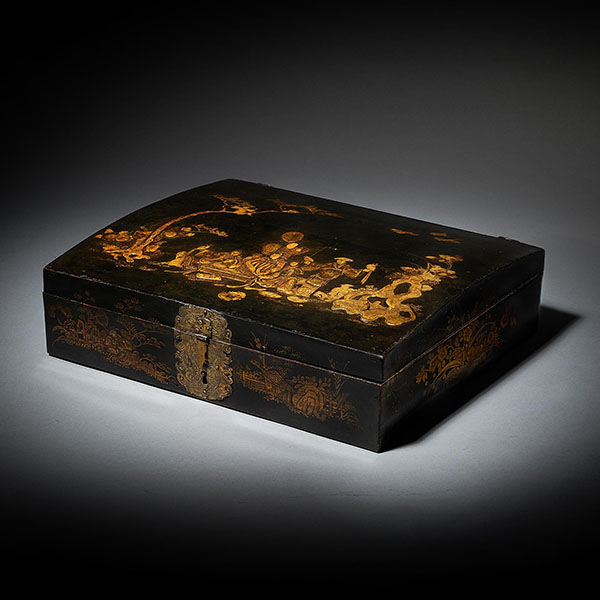
18th Century George I Domed Topped Japanned Chinoiserie Falconry Box
18th Century George I Domed Topped Japanned Chinoiserie Falconry Box, circa 1710 £3,900Follow Us18th Century George I Domed Topped Japanned Chinoiserie Falconry Box, circa 1710 A rare and important Queen Anne - George I japanned chinoiserie...

18th Century George II Scarlet-Red Japanned Corner Cupboard Att. Giles Grendey
18th Century George II Scarlet/Red Japanned Corner Cupboard, Att. Giles Grendey Follow Us18th Century George II Scarlet/Red Japanned Corner Cupboard, Att. Giles Grendey A fine and rare early 18th century George II scarlet japanned chinoiserie...

18th-Century George II Mahogany Secretaire Linen Press, Attributed, Giles Grendey
18th-Century George II Mahogany Secretaire Linen Press, Attributed, Giles Grendey £10,800[wpforms_selector form_id="11387" show_title="on" _builder_version="4.22.1" _module_preset="default" custom_margin="-30px||||false|false"...

Signed Mid 19th C. Edo/Meiji Period Diminutive Lacquer Stacking Cabinet, Japan
Signed Mid 19th C. Edo/Meiji Period Diminutive Lacquer Stacking Cabinet, Japan £5,800Follow UsSigned Mid 19th C. Edo/Meiji Period Diminutive Lacquer Stacking Cabinet, Japan The highly decorated tray in the form of a table frames a series of...

Late Edo Period 19th Century Japanese Pillar Clock, Shaku-Dokei, C. 1820
Late Edo Period 19th Century Japanese Pillar Clock, Shaku-Dokei, C. 1820 £6,500Follow UsLate Edo Period 19th Century Japanese Pillar Clock, Shaku-Dokei, C. 1820 ELEGANT JAPANESE PILLAR CLOCK, 'SHAKU-DOKEI', c. 1820 The very fine 30-hour,...

George II Gun Barrel Mahogany Tripod Table, circa 1740-1750
George II Gun Barrel Mahogany Tripod Table, circa 1740-1750 SoldFollow UsGeorge II Gun Barrel Mahogany Tripod Table, circa 1740-1750 George II Gun Barrel Mahogany Tripod table. The well-figured top has a pie crust edge, resting on a gun...

18th Century George I Domed Topped Japanned Chinoiserie Falconry Box
18th Century George I Domed Topped Japanned Chinoiserie Falconry Box, circa 1710 £3,900Follow Us18th Century George I Domed Topped Japanned Chinoiserie Falconry Box, circa 1710 A rare and important Queen Anne - George I japanned chinoiserie...






